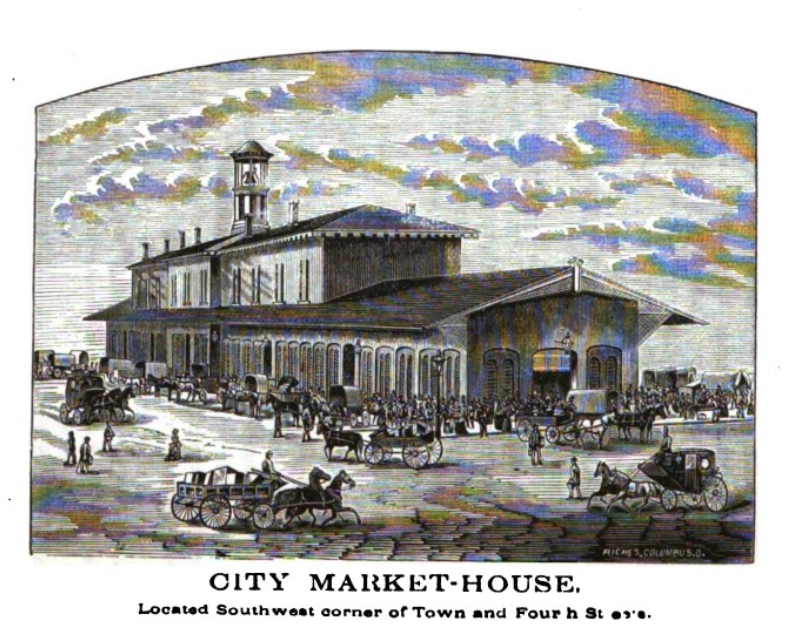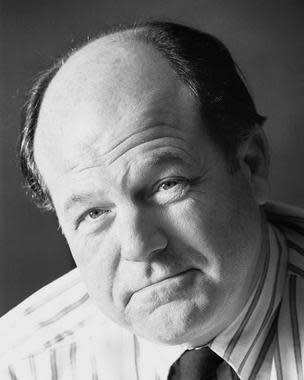North Market is oldest survivor among Columbus' public markets that date back to 1814

Columbus has been a market town since it began as a created city more than 200 years ago.
Founded in 1812 on the highbanks at the forks of the Scioto and Olentangy Rivers, Columbus grew quite slowly at first as early settlers hacked their homes from a dense forest in the middle of the War of 1812. The earliest public building in the new town was the Ohio Penitentiary, which was located at the place where the Priscilla R. Tyson Cultural Arts Center on East Main Street sits today. Prisoners were put to work helping to build the Ohio Statehouse and other buildings in and around Statehouse Square while other enterprising newcomers were building homes, taverns and hostelries in the town.
One of the first commercial structures built in the town by its four "proprietors" was a public market. Built in 1814 on High Street just south of Rich Street, the simple, two-story wood structure was a place for residents to obtain fresh food of all sorts as it became available.

The new market met people’s needs, but sitting in the middle of the street it was in the wrong place as coach and wagon traffic had to first avoid a 40-foot Native American mound at Mound Street and then had to work one’s way around the market.
In 1817, members of a newly established City Council of the new Borough of Columbus decided to move the market and built a new one on State Street just west of High Street. This more substantial structure worked quite well as a market as well as a meeting place for city officials and local residents. The market on State Street met the needs of Columbus residents for the next 30 years. But in those years Columbus began to grow as a regional center.
In 1831, the Ohio Canal and the National Road came to Columbus. A town of 2,000 people in 1832 became acity of 5,000 people by 1834. With the arrival of a large number of new immigrants from Ireland and Germany, Columbus officials found by the 1840s that more people needed more market. So city officials in 1849 purchased an entire city block along 4th Street between Town and Rich streets for $2,000.
Later that year, a whole new market that ran the entire length of the city block was opened for business. It was a busy place. In an era when an “ice box” was just that, most food had to be used quickly unless it was not canned or dried for later use. People went to market quite frequently and bought just what was needed for immediate use.
Peletiah Webster Huntington came to Columbus seeking his fortune and found it working at local banks. In 1866, he opened his own bank on the southwest corner of Broad and High streets. Each morning, he left his home on Broad Street and walked a couple of blocks to his banking house. He carried an umbrella if needed, and usually carried his willow market basket. He also picked up twigs and branches in the local street gutters.
"P. W." spent his days on the steps of his bank, whittling those pieces of wood while asking passers by to consider visiting his bank. At the end of the day, he walked to the market and bought the foods he favored for his family. Huntington was a friendly and frugal sort of fellow, and a very successful banker as well.
The second floor of Central Market was a meeting hall, home for Columbus City Council, and served as a local courtroom. A two-story brick jail was built just south of Central Market. Court and Council meetings were rather interesting to hear and behold as dozens of live chickens, pigs and goats were bleating just below.
Columbus City Council moved to a new City Hall in 1872, but the public uses of the second floor meeting hall at the Central Market continued — notwithstanding the noise below.
As Columbus grew, so too did the need for markets. By the turn of the 20th century there were smaller North, West, East and South Markets in operation. Heavily remodeled and rebuilt in 1930, Central Market at peak served 20,000 people every Saturday, with as many as 65 meat vendors.
But as Columbus grew, the neighborhood around the Central Market declined as more suburban areas grew. By the 1950s, the planning doctrine of ‘urban renewal’ was in vogue. A 60-acre area south and west of Statehouse Square was slated for demolition as the Market-Mohawk area. In 1966, after an unsuccessful struggle to save it, Central Market was demolished and a bus station took its place.
Yet even today, in the age of supermarkets and the ability to order food through the internet to be delivered to your house, there is still a desire for public markets.
North Market, owned by the City of Columbus, has been around since 1876 and is still going strong. In fact, numerous improvements and an 18,000-square-foot expansion at North Market are part of the plans with the construction of the 32-Merchant Building apartment and hotel tower that is being built in the market's former parking lot.
And the East Market food hall is now operating in a rebuilt trolley car barn in the Franklin Park neighborhood.
Many people in the Columbus area just simply like to go to market.
Local historian and author Ed Lentz writes this "As It Were" history column for The Dispatch.
This article originally appeared on The Columbus Dispatch: Since 1814, Columbus has had public markets. North Market oldest left

